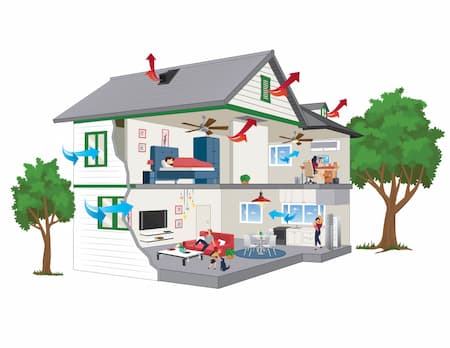The Pros & Cons Of Whole House Fans

Are you looking for information about the pros and cons of whole house fans? Here in the Rancho Santa Margarita, most people love them because we're located in a climate where they're super beneficial to save on costly air conditioning.
There are many homeowners who absolutely love their whole house fan, but they're not for everyone. If you want to see if this system may be right for you, take a look at the following pros and cons of whole house fans to get the info you need.
Remove The Stale Indoor Air That Can Contain Airborne Pathogens & Viruses From Inside Your Home
Comfort Cool Fans whole house fans are designed to bring in cool, fresh, clean air from outside while removing the air from inside, significantly improving the quality of air your family breathes.
According to the Lung Association, effective ventilation may also help keep bacteria, viruses and other pollutants out of the indoor air. Research shows that airflow and ventilation can alter how diseases spread indoors. The more stagnant the air is, the more likely diseases are to spread. Like the lungs, homes need to be able to breathe to make sure that fresh air comes in and dirty air goes out. Indoor air can build up high levels of moisture, odors, gases, dust, and other air pollutants. To keep the air safe indoors, fresh outdoor air is needed to dilute these indoor pollutants
Pros: Why People Love Whole House Fans
- Whole house fans can help homeowners to save a significant amount on their cooling costs in climates where the nights are cool.
- New models like our Centric Air whole house fans only cost pennies per hour to run.
- Newer models operate quietly with the better brands offering an ultra-quiet operation.
- New models don't need additional attic framing.
- New whole house fans with enclosed motors are maintenance-free.
- Circulates the air in the home and attic to provide cool comfort.
Cons: Why People Don't Like Whole House Fans
Most of the complaints about whole house exhaust fans are from homeowners who didn't get a good installation or are living with an older model. Whole house fans entered the market about 50 years ago and have been greatly improved by manufacturers like Comfort Cool Fans.
With newer models that are well made and a proper installation, you shouldn't have to deal with most of the following cons of whole house fans. However, they're still not for everyone, so read on!
- Older models often use up to 1000 watts of electricity. An average central air conditioner uses 3K to 5K watts per hour.
- Building codes often require about 1 foot of net free area for every 750 CFM of fan airflow, some homes cannot accommodate them. If installed anyway, they won't work well.
- Whole house fans which are large enough to create a breeze through the house can sometimes produce unintended effects such as noise, heat loss, and house depressurization. This can be improved with more attic vents and window area to replace the exhausted air.
- You must open windows. Owners often forget to open the windows while the fan is running, creating a backdraft. This can cause the fan motor to burn out and may possibly backdraft a gas water heater or appliance.
- Older models are very loud and an improper installation can cause the unit to vibrate and make excessive noise.
- Older belt-driven models require maintenance every couple of years.
- Some older models require the addition of extensive framing in the attic.
- Whole house fans are best used in climates where the nights are cool. They won't save as much energy in very hot climates and aren't feasible to use on hot and humid days.
